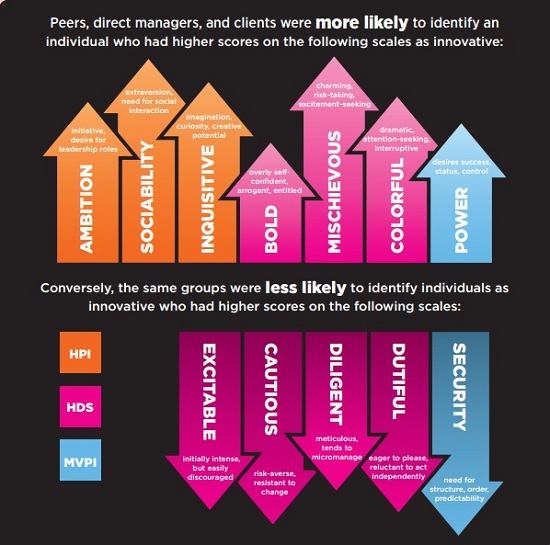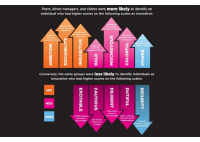5 Ways to Manage Creativity and Drive Innovation
02 Oct 2013
According to a study conducted by Adobe, a global producer of digital marketing and media tools, more than 80% of people believe that creativity is critical to economic growth. However, for all of its importance, few organizations understand or are willing to do what it takes to keep their creative people happy and productive.
Who Are the Innovators?
In Adobe’s study, 52% of U.S. respondents identified themselves as creative. According to Dr. Tomas Chamorro-Premuzic, vice president of research and innovation at Hogan Assessments, that number is exaggerated.
“In the U.S., creativity is seen as a desirable personality characteristic, especially in business,” he said. “What we are likely seeing in these results is something psychologists call the better-than-average effect – individuals consistently rate themselves better than average along desirable qualities.”
What Constitutes a Creative Personality?
Psychologists from the Hogan Research Division recently compared 360 feedback data with personality data measured using three personality assessments – the Hogan Personality Inventory, which measures people’s everyday strengths and weaknesses; the Hogan Development Survey, which measures strengths that people overuse under increased stress or pressure; and the Motives, Values, Preferences Inventory, which measures the core drivers that determine what people desire and what they are willing to work for.

What Does Any of That Mean in Practical Terms?
Drs. Robert Hogan and John Morrison described the creative personality in their 1996 chapter Managing Creativity:
- Creative people are open to new experiences.
- They accept information from a variety of sources, and feel a need to organize and make sense of this information.
- They have relatively high energy.
- They have the ability to easily produce an abundance of ideas.
- Finally, creative individuals tend to be concerned with their personal adequacy, and one of their strongest motivations is to prove themselves.
That sounds like an ideal employee, but here’s the rub. From the previous section, we can surmise that creative people are idealistic, nonconforming, and tend to be unconcerned about money. Conversely, according to Hogan and Morrison, good managers tend to be stable, practical, and concerned with maintaining order and controlling costs.
From a psychological perspective, managerial and creative personalities are natural organizational enemies who are predisposed not to understand one another. However, although they are psychological opposites, managers and creative people need one another. Good managers are not necessarily naturally innovative or imaginative, and creative people aren’t typically good managers.
So what can organizations do to ensure they are properly managing their creative employees and driving innovation?
1. Give them time, space and resources.
In 1984, Teresa Amabile interviewed 46 managers of research and development groups from corporations in the U.S., Canada, and Mexico. She asked them to recount examples of high and low creativity in their laboratories. The most frequently cited obstacles to creativity: employees’ lack of control over their own work, time pressure, and lack of resources.
“Creativity is enhanced by giving people more freedom and flexibility at work,” said Chamorro-Premuzic. “Don’t constrain your creative employees, don’t force them to follow processes or structures. Let them work remotely and outside normal hours; don’t ask where they are, what they are doing, or how they do it. Everyone is more likely to be creative in spontaneous, unpredictable circumstances.”
2. Surround them with (sort of) boring people
“The worst thing you can do to creative employees is force them to work with other creative employees,” said Chamorro-Premuzic.
The previously discussed 360 data demonstrates that innovative individuals are driven by the desire for success and control and display above-average drive and competitiveness. When two of these personalities collide, they tend to compete for ideas or keep them to themselves.
“That said, you cannot surround creative people with really boring or conventional people,” said Chamorro-Premuzic. “They would not understand them and fall out. The key is finding a happy medium.”
Support your creative employees by surrounding them with colleagues who are too conventional to challenge their ideas, but unconventional enough to collaborate with them. Teams that perform the most effectively are a mix of creative members and people more prone to pay attention to details and processes.
3. Motivate them without money.
Few people would argue with a bonus check on their desk at the end of the year, but it turns out that monetary rewards systems are poor drivers of performance among creative individuals. A meta-analysis by Edward Deci and colleagues showed that when subjects knew in advance how much extra money they would receive for completing a task that they already found interesting or enjoyable, motivation decreased by 36%.
So, how do you motivate your creative employees? Give them meaningful work.
“Our research shows that innovators tend to have more vision,” said Chamorro-Premuzic. “They see the bigger picture and are able to understand why things matter. The downside to this is that they are reluctant to engage in meaningless work.”
4. Set goals.
In their chapter, Hogan and Morrison recall interviewing the vice president for research and development at a major computer manufacturing firm, the survival of which depended on the success of its R&D department.
“We mentioned it must be difficult to manage creativity,” they stated. “He said it is not so difficult, that the key is good goal setting. He recommended asking the researchers what they thought they could accomplish in a certain timeframe, then supporting their efforts and keeping them on track.”
Likewise, Amabile found that the presence of some time pressure served to motivate creative employees.
5. Give bad managers the boot.
All of the factors that negatively impact creativity are the result of poor management. Managers who are unable to build and maintain productive relationships with creative individuals, set clear performance expectations, or give clear or credible feedback are bound to crush their employees’ creative spirits.
Unfortunately, the base rate for managerial incompetence is about 60%. This may help account for the fact that, in Adobe’s survey, only one in four respondents said they were living up to their creative potential.
Published in Romania-Insider






